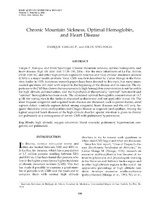Mostrar el registro sencillo del ítem
Chronic mountain sickness, optimal hemoglobin and heart disease
| dc.contributor.author | Vargas, Enrique | |
| dc.contributor.author | Spielvogel, Hilde | |
| dc.date.accessioned | 2016-11-07T18:07:55Z | |
| dc.date.available | 2016-11-07T18:07:55Z | |
| dc.date.issued | 2006-06 | |
| dc.identifier.uri | http://repositorio.umsa.bo/xmlui/handle/123456789/9111 | |
| dc.description.abstract | Abstract. For the male inhabitants of La Paz, Bolivia (3200–4100 m), and other high altitude regions in America and Asia, chronic mountain sickness (CMS) is a major health problem. Since CMS was first described by Carlos Monge in the Peru vian Andes in 1925, numerous research papers have been devoted to this topic, but many unan swered questions still exist with respect to the beginning of the disease and its cause(s). The ex perience with CMS has shown that an excessively high hemoglobin concentration is not favorable for high altitude acclimatization, and the hypothesis of theoretically “optimal” hematocrit and “optimal” hemoglobin has been made. The calculated optimal hemoglobin concentration of 14.7 g/dL for resting men in the Andes is discussed as theoretical and not applicable in real life. The most frequent congenital and acquired heart diseases are discussed, such as patent ductus, atrial septum defect, ventricle septum defect among congenital heart diseases and the still very fre quent rheumatic valve cardiopathies and Chagas disease as acquired cardiopathies. Among the typical acquired heart diseases of the high altitude dweller, special attention is given to chronic cor pulmonale as a consequence of severe CMS with pulmonary hypertension. | es_ES |
| dc.language.iso | en | es_ES |
| dc.publisher | High Altitude Medicine & Biology | es_ES |
| dc.subject | GRAN ALTITUD | es_ES |
| dc.subject | SATURACIÓN DE OXÍGENO | es_ES |
| dc.subject | VISCOSIDAD DE LA SANGRE | es_ES |
| dc.subject | HIPERTENSIÓN PULMONAR | es_ES |
| dc.subject | CONGÉNITO | es_ES |
| dc.title | Chronic mountain sickness, optimal hemoglobin and heart disease | es_ES |
| dc.type | Article | es_ES |

